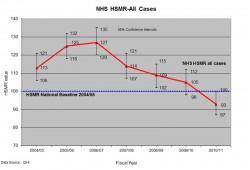 NIAGARA, ON: New data shows the Niagara Health System (NHS) is making significant progress in improving patient safety and quality of care.
NIAGARA, ON: New data shows the Niagara Health System (NHS) is making significant progress in improving patient safety and quality of care.
The Hospital Standardized Mortality Ratio (HSMR), released yesterday by Canadian Institute for Health Information (CIHI), is one of a number of quality and safety measures designed to improve patient care. Hospitals use measures like HSMR to develop action plans to monitor performance and identify improvement opportunities.
NHS’s HSMR for 2010-11 is 93, compared to 105 for 2009-10. The HSMR is based on a complicated calculation. A score of 100 indicates there are more actual deaths than what was expected, and less than 100 shows there are fewer deaths than expected. The HSMR is based on specific diagnosis groups (including pneumonia, chronic obstructive pulmonary disease and heart attack), which account for 80% of all in-hospital deaths.
“We have seen steady and dramatic improvement in our annual HSMR since it was introduced by the CIHI in 2006-07,” says Dr. Jeff Cranford, NHS Chief of Surgery. “Our target for 2010-2011 was 95, and we have surpassed that target due in large part to a number of major new initiatives that have positively influenced the care we provide.”
These new initiatives are:
- Sepsis protocol at all of our sites: The sepsis protocol is designed to identify the early onset of infection and treatment of the patient’s infection. This assessment tool is initiated at triage in the ERs and Urgent Care Centres and on inpatient units.
- Niagara Early Warning System (NEWS): NEWS is an assessment tool used on the Medical and Surgical units at the three large sites to assess changes in a patient’s condition. Abnormal vital signs are visually flagged and trigger an early response to intervention.
- Venous Thromboembolism (VTE) prevention strategy to reduce or prevent blood clots and embolisms and the complications that can arise from them. Incidence of VTE can be substantially reduced or prevented by identifying patients at risk and providing appropriate interventions. Patients who are hospitalized or undergoing surgery can be at risk of VTE due to limited mobility and other factors.
The major factors influencing our HSMR continue to include: a high prevalence of chronic disease in Niagara; a shortage of family physicians to provide primary care; a high number of cancer and palliative patients in Niagara; and a high number of alternate level of care patients residing in hospitals due to the lack of available long-term care and rehabilitation facilities in the community.
“Our team of healthcare providers will continue to strive for improvement,” says Dr. Cranford. “We are hopeful that our patient safety initiatives will reap further benefits and contribute to continued improvement in the overall HSMR and quality of care being provided to our patients.”

